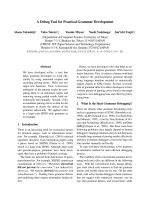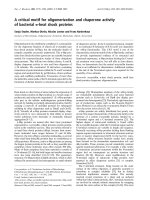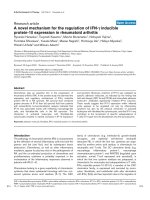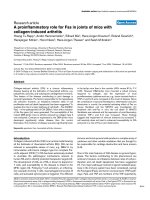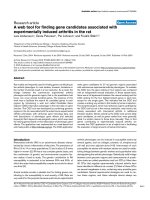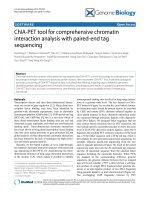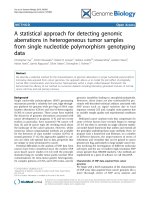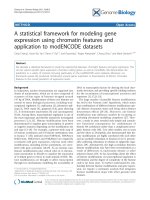Báo cáo y học: "A web tool for finding gene candidates associated with experimentally induced arthritis in the rat" docx
Bạn đang xem bản rút gọn của tài liệu. Xem và tải ngay bản đầy đủ của tài liệu tại đây (163.95 KB, 8 trang )
Open Access
Available online />R485
Vol 7 No 3
Research article
A web tool for finding gene candidates associated with
experimentally induced arthritis in the rat
Lars Andersson
1
, Greta Petersen
1
, Per Johnson
1
and Fredrik Ståhl
1,2
1
Department of Cell and Molecular Biology – Genetics, Goteborg University, Sweden
2
School of Health Sciences, University College of Borås, Borås, Sweden
Corresponding author: Lars Andersson,
Received: 2 Dec 2004 Revisions requested: 4 Jan 2005 Revisions received: 20 Jan 2005 Accepted: 24 Jan 2005 Published: 18 Feb 2005
Arthritis Research & Therapy 2005, 7:R485-R492 (DOI 10.1186/ar1700)
This article is online at: />© 2005 Andersson et al.; licensee BioMed Central Ltd.
This is an Open Access article distributed under the terms of the Creative Commons Attribution License ( />2.0), which permits unrestricted use, distribution, and reproduction in any medium, provided the original work is properly cited.
Abstract
Rat models are frequently used for finding genes contributing to
the arthritis phenotype. In most studies, however, limitations in
the number of animals result in a low resolution. As a result, the
linkage between the autoimmune experimental arthritis
phenotype and the genomic region, that is, the quantitative trait
locus, can cover several hundred genes. The purpose of this
work was to facilitate the search for candidate genes in such
regions by introducing a web tool called Candidate Gene
Capture (CGC) that takes advantage of free text data on gene
function. The CGC tool was developed by combining genomic
regions in the rat, associated with the autoimmune experimental
arthritis phenotype, with rat/human gene homology data, and
with descriptions of phenotypic gene effects and selected
keywords. Each keyword was assigned a value, which was used
for ranking genes based on their description of phenotypic gene
effects. The application was implemented as a web-based tool
and made public at />. The CGC application
ranks gene candidates for 37 rat genomic regions associated
with autoimmune experimental arthritis phenotypes. To evaluate
the CGC tool, the gene ranking in four regions was compared
with an independent manual evaluation. In these sample tests,
there was a full agreement between the manual ranking and the
CGC ranking for the four highest-ranked genes in each test,
except for one single gene. This indicates that the CGC tool
creates a ranking very similar to that made by human inspection.
The exceptional gene, which was ranked as a gene candidate by
the CGC tool but not in the manual evaluation, was found to be
closely associated with rheumatoid arthritis in additional
literature studies. Genes ranked by the CGC tools as less likely
gene candidates, as well as genes ranked low, were generally
rated in a similar manner to those done manually. Thus, to find
genes contributing to experimentally induced arthritis, we
consider the CGC application to be a helpful tool in facilitating
the evaluation of large amounts of textual information.
Introduction
Rheumatoid arthritis (RA) is an autoimmune disease charac-
terised by chronic inflammation of the joints. The prevalence of
RA is 0.5 to 1% in many populations [1] and is about 2.5 times
higher in women [2]. RA has a very complex genetic basis, and
the combination of genetic and environmental causative fac-
tors makes it hard to study. The genetic contribution to RA
susceptibility is estimated to be between 30% and 50%, of
which the major histocompatibility complex accounts for about
one-third [3].
Animal models provide a valuable tool for finding genes con-
tributing to the susceptibility to and severity of RA. Rats are
very useful for this purpose because autoimmune experimental
arthritis phenotypes can be induced in susceptible strains by
several agents, such as collagen, pristane, oil, streptococcal
cell wall and even adjuvant alone [4-6]. Intercrosses of such
susceptible rat strains with resistant strains are used for estab-
lishing linkage between genetic markers and quantitative traits
distinguishing the arthritis phenotype. Statistically valid linkage
between such genomic regions and measurements of quanti-
tative traits are called quantitative trait loci (QTLs). More than
40 QTLs that regulate experimentally induced arthritis have
been identified in different rat crosses [7]. Most of these QTLs
are several megabases in size, containing many possible gene
candidates. Several experimental strategies are used to nar-
row these regions, and these attempts almost always are
Aia = Adjuvant-induced arthritis; CGC = Candidate Gene Capture; Cia = Collagen-induced arthritis; NCBI = National Centre for Biotechnology Infor-
mation; OMIM = Online Mendelian Inheritance in Man; Pia = Pristane-induced arthritis; QTL = quantitative trait locus; RA = rheumatoid arthritis.
Arthritis Research & Therapy Vol 7 No 3 Andersson et al.
R486
combined with the retrieval of potential candidate genes found
in different databases.
Information about RA and related genome data is available in
several different forms, from raw data to descriptive text. One
important difference between raw data and data based on
human evaluation is that human evaluation often yields an
interpretation that gives meaning to the data. Thus, human
considerations bring an added value to genome data, which
makes textual description an important source for investigating
gene function. However, the amount of free text about RA is
growing very fast, so there is an increasing need for develop-
ing a tool to help scientists distinguish relevant information
from background noise. To facilitate this kind of data mining,
we have created a tool, the Candidate Gene Capture (CGC)
application, that makes keyword-based searches on textual
information for genes situated within selected human chromo-
somal intervals that are homologous to a given rat QTL.
Depending on the connection to RA, the keywords are allo-
cated different values. The values for all matching keywords
are summarised for each gene, the final values indicating
which genes might be good candidates for contributing to the
arthritis phenotype. When evaluated, this approach produces
similar rankings to those done manually. In addition, this
approach also manages to predict several candidate genes
that are already established in the literature. Thus, the CGC
application is a helpful tool for finding candidate genes asso-
ciated with experimentally induced arthritis in rat.
Materials and methods
The focus of this work is the development of a web-based tool
that facilitates the identification of potential gene candidates
that contribute to experimentally induced autoimmune arthritis.
The application, called CGC, was created by combining QTL
regions in rat with human gene homology data, descriptions of
phenotypic gene effects and selected keywords.
QTL data
Data describing 37 experimentally induced autoimmune arthri-
tis QTLs in rat were obtained from the RatMap database [7].
These data were originally collected from experimentally
induced inflammatory arthritis in rat strains susceptible to the
following inducing agents: pristane, collagen, streptococcal
cell wall, oil or adjuvant alone. Accordingly, the resulting QTLs
are named Pristane-induced arthritis (Pia), Collagen-induced
arthritis (Cia), Streptococcal cell wall-induced arthritis
(Scwia), Oil-induced arthritis (Oia) and Adjuvant-induced
arthritis (Aia).
The QTL data retrieved from RatMap include the locus symbol,
a QTL description, the chromosomal position and flanking
markers defining the borders of the QTL. The range of each
QTL was based on the LOD score thresholds suggested in
the corresponding papers. These data were stored in a
MySQL table labelled 'QTL'.
Gene homology data
Human gene data were assembled primarily from National
Centre for Biotechnology Information (NCBI) [8] and the Uni-
versity of California Santa Cruz genome browser [9]. The
genome information from NCBI consisted of official gene sym-
bol, chromosome number, Locus Link ID, Online Mendelian
Inheritance in Man (OMIM) ID, human Genome Database
(GDB) accession ID and Refseq ID. Sequence positions were
obtained exclusively from the University of California Santa
Cruz genome browser, comprising transcript start/stop,
codon start/stop, exon start/stop and number of exons in each
gene. From this set of data, a table of human genes ordered by
codon start was generated and labelled 'HsRn'.
To find orthologous gene pairs between rat and human, 1,464
chromosomally localised rat genes were obtained from Rat-
Map. About 1,000 of these genes had a known homologous
gene mapped in human. The orthologous rat/human gene
pairs were characterised by the human data already present in
table 'HsRn' together with the official rat gene symbol, rat
chromosome number and RatMap ID.
Two flanking markers define each QTL used in this study. To
find a human sequence homologous to a rat QTL region, an
integrated linkage map containing rat genes and polymorphic
DNA markers was used />gene_mapping_data/integrated_linkage_maps/. For each
QTL a pair of rat genes (obtained from the integrated linkage
map) that were localised at, or close to, the two markers flank-
ing the QTL and orthologous to human genes, was selected.
The human chromosomal interval defined by these two orthol-
ogous genes was expected to contain a sequence homolo-
gous to the rat QTL. Because the homologous QTL interval
often contained segments from more than one human chromo-
some, all orthologous rat/human gene pairs within each QTL
were used to find smaller human chromosomal segments to
comprise the total list of human genes confined within the
homologous region. Information on rat and human gene sym-
bols, chromosomal positions and codon start for all genes
included in the homologous interval (obtained from table
'HsRn') was stored in QTL-specific tables labelled with the
same symbol as the corresponding QTL.
Downloading gene function data
The OMIM database [10] contains a comprehensive record of
gene function and clinical data, which was used as a source
for keyword querying in the CGC application. For each human
gene within the selected intervals, gene function information
was downloaded from OMIM and stored in a table labelled
'OMIMdata'.
Selecting keywords and running the application
The querying process in this application is divided into four
steps: finding a QTL of interest, displaying the rat/human
Available online />R487
homologous QTL region, selecting and ranking keywords, and
searching OMIM text for selected keywords.
Finding a QTL of interest
The first step in finding candidate genes for a specific QTL is
to choose a QTL of interest. To make this possible, we simply
made the QTL database table directly available through a web
interface. In this way, the user can access all QTLs in our data-
base by searching for the locus symbol, the chromosome
number and/or a descriptive text. The resulting QTLs are pre-
sented, together with a brief description obtained from the
QTL table.
Displaying the rat/human homologous QTL region
Next, the user can select the preferred QTL. The resulting web
page presents all rat/human gene pairs within the chosen rat
QTL region, together with all human genes in the homologous
human genomic region that are found in OMIM. These data are
obtained from the corresponding 'QTL-specific' table.
Thus, all rat genes within a selected QTL and all genes within
the homologous human genomic region are displayed.
Because the human genome is better characterised than the
rat genome, more human genes are usually displayed.
Selecting and ranking of keywords
For all arthritis QTLs a total of 49 default keywords were cho-
sen. Most keywords were obtained by selecting all terms
found directly under the MeSH (Medical Subject Headings)
terms 'autoimmune diseases' and 'rheumatoid arthritis' in the
PubMed MeSH-term database [11]. Some of these terms
were truncated to optimise the querying process. In addition,
a set of keywords frequently used in arthritis-related literature
was added to the default keyword list.
To estimate the relative importance of the default keywords in
relation to arthritis, each keyword was given a value depending
on its relevance to arthritis. This relevance index was calcu-
lated as the number of PubMed abstracts containing both the
keyword and the word 'arthritis' divided by the total number of
abstracts containing the keyword alone. The relevance indices
were multiplied by 100 to generate the final keyword values as
percentages.
The application also allows the user to add up to 10 keywords
of his or her own choice, and the corresponding keyword val-
ues are automatically generated on the basis of the same prin-
ciple as for the default keyword values. Optionally, the user
can overrule all keyword values, including the default ones.
Searching OMIM text for selected keywords
When searching a QTL for all the default keywords, alterna-
tively deselecting unwanted ones and/or adding new ones, the
keyword values for all keywords found within each OMIM text
(locally stored in the table 'OMIMdata') will be summarised. To
take advantage of the large amount of knowledge concerning
the human genome, records in OMIM for all genes within the
human homologous segment are used in the search, including
genes not present in the rat gene list. For each gene, the total
sum of all keyword values will be displayed, which indicates its
relevance as a candidate gene. Each keyword is only counted
once, independently of the number of times it occurs within a
given OMIM text.
Results
In the CGC application presented in this paper, all known rat
genes within a selected QTL, along with all human genes
within the homologous interval, are retrieved and displayed
from a table that has the same name as the selected QTL. A
list with an array of 49 selectable arthritis related keywords is
presented together with their respective keyword values. Up to
10 additional keywords can be added and their keyword val-
ues are automatically calculated. When performing a search,
the textual information for each human gene stored in the table
'OMIMdata' is scanned for all selected keywords. The genes
and all keywords found in the accompanying text are dis-
played, together with the sum of all matching keyword values.
To estimate whether the CGC application was able to rank
candidate genes in fashion similar to human evaluations, gene
descriptions for four randomly selected QTL regions (Cia4,
Cia10, Cia14 and Cia17) were surveyed manually. For all
genes within the selected QTL regions, we compared the out-
come of the CGC gene ranking with our own manual evalua-
tion of each OMIM text. The manual rating was made without
knowledge of the CGC ranking. To put the application and the
manual inspection at a similar level, we tried to base our eval-
uation on the written OMIM texts only, without taking other
information into account. In the manual inspection the OMIM
texts were divided into five different classes: (1) obvious gene
candidate, (2) likely gene candidate, (3) possible gene candi-
date, (4) unlikely gene candidate and (5) gene without
relevance.
In addition, the genes that were ranked as high by the CGC
application were further scrutinised in an extensive analysis of
related papers not found in the OMIM reference lists. Finally,
the NCF1 gene was studied in detail.
Cia4
In total, 12 genes were ranked by the CGC tool. IFNG was
rated as the top candidate by the CGC application and it was
also considered to be the most appropriate gene candidate for
collagen-induced arthritis within this QTL according to the
manual inspection. IL22 was considered the next highest gene
candidate both by the CGC application and the manual
inspection.
Arthritis Research & Therapy Vol 7 No 3 Andersson et al.
R488
IFNG (interferon-
γ
), CGC points 291.1, CGC ranking 1,
manual rating 1
IFNG was identified by the CGC application on the basis of
10 different keywords: 'rheumatoid', 'HLA', 'sjogren', 'T cell',
'mhc', 'lymphocyte', 'antigen', 'cytokine', 'arthritis' and 'infecti'.
IFNG has been shown to be closely associated with RA. In a
study of 99 patients with RA of different severity, susceptibility
to, and severity of, RA was shown to be related to a microsat-
ellite polymorphism within the first intron of the gene encoding
interferon-γ [12].
IL22 (interleukin-22), CGC points 14.1, CGC ranking 2,
manual rating 2
IL22 was selected by the keywords 'inflam', 'T cell', 'lym-
phocyte' and 'cytokine'. IL22 activates three different STAT
genes: STAT1, STAT3 and STAT5 [13]. RA synovial fibrob-
lasts are relatively resistant to apoptosis and exhibit dysregu-
lated growth. Retrovirus-mediated gene transfer of dominant-
negative mutant STAT3 genes blocks the endogenous STAT3
expression in synovial fibroblasts from patients with RA, lead-
ing to failure of growth in the cell culture and apoptosis [14].
A middle group of two genes was selected with the CGC
application: MYC (CGC points 10.9, CGC ranking 3, manual
rating 3) and HMGIC (CGC points 10.5, CGC ranking 4,
manual rating 4).
Cia10
In total, 35 genes were ranked by the CGC tool. RPL7 and
NKFB1 were ranked as the two top candidates by the CGC
application. These two genes were also manually considered
to be the most appropriate gene candidates for collagen-
induced arthritis within this QTL.
NFKB1 (nuclear factor
κ
B 1), CGC points 219.7, CGC
ranking 1, manual rating 1
The very high point that NFKB1 obtained from the keyword
query was in part due to the word 'arthritis' appearing in the
corresponding OMIM text. Twelve other keywords were also
found to be making a substantial contribution. According to
the OMIM record, NFKB1 is a very strong gene candidate
because the inappropriate activation of NKFB1 is known to be
linked to inflammatory events associated with autoimmune
arthritis [15].
RPL7 (ribosomal protein L7), CGC points 37.3, CGC
ranking 2, manual rating 1
The RPL7 gene was rated second by the CGC application
mainly because of the keywords 'autoimmune', 'lupus' and 'ery-
thematosus'. The RPL7 protein is reported to be a major
autoantigen in systemic autoimmune arthritis [16].
A middle group of five genes was rated as relatively high by the
CGC application: COL6A3 (CGC points 24.2, CGC ranking
3, manual rating 3), CSF1 (CGC points 17.4, CGC ranking 4,
manual rating 3), EDG1 (CGC points 12.5, CGC ranking 5,
manual rating 5), VCAM1 (CGC points 11.3, CGC ranking 6,
manual rating 2) and PAPSS1 (CGC points 9.3, CGC ranking
7, manual rating 3). Among these genes, CSF1 is a possible
gene candidate because recent studies have shown that syn-
ovial tissue in RA joints secretes CSF1 together with several
other cytokines, which increases the osteoclast activity [17].
VCAM1 might also be a potential gene candidate because it
is expressed in endothelial cells of the blood vessels, facilitat-
ing the adhesion of leucocytes [18]. EDG1 was a false predic-
tion because the term 'HLA' matched an author (Hla T. Maciag
T. J Biol Chem 1990;265:9308-13) and the term 'T cell'
matched 'mutant cell'.
Cia14
In total, 16 genes were ranked by the CGC tool. The two top
ranked genes according to the CGC application (IL15 and
HMOX1 ) were also the highest-rated genes in the manual
inspection.
IL15 (interleukin-15), CGC points 27.3, CGC ranking 1,
manual rating 1
IL15 was ranked in first place by the CGC application. In the
corresponding OMIM text, IL15 is associated with the key-
words 'autoimmun', 'inflam', 'T cell', 'lymphocyte', 'antigen',
'cytokine' and 'infecti', but not 'arthritis'. In a recent paper it
was shown that increased serum levels of IL15 are found in
patients with long-term RA [19].
HMOX1 (haem oxidase 1), CGC points 13.5, CGC ranking
2, manual rating 1
HMOX1 was ranked second by the CGC application with the
keywords 'anemia', 'hemolytic', 'inflam' and 'T cell'. HMOX1
has been shown to be involved in the treatment of RA with
gold(I)-containing compounds. Gold(I) drugs selectively acti-
vate a transcription factor (Nrf2/small Maf heterodimer), which
induces the transcription of anti-oxidative stress genes, includ-
ing HMOX1, and inhibits inflammation [20].
A middle group of four genes were rated as relatively high by
the CGC application: ITK (CGC points 9.7, CGC ranking 3,
manual rating 2), NFATC3 (CGC points 9.7, CGC ranking 3,
manual rating 3), AARS (CGC points 9.2, CGC ranking 5,
manual rating 3) and KARS (CGC points 9.2, CGC ranking 5,
manual rating 3).
Cia17
In total, 30 genes were ranked by the CGC tool (only one
member of the PCDH gene family was included). In the man-
ual inspection, no 'obvious' candidate gene was found. How-
ever, four genes were considered to be 'likely' gene
candidates. One of these, CD74, also received the highest
keyword sum in the CGC application. Another gene among
the likely gene candidates, SLC26A2, was ranked second by
the CGC application.
Available online />R489
CD74, CGC points 27.7, CGC ranking 1, manual rating 3
The CD74 gene was ranked in first place by the CGC appli-
cation because of results from six different keywords: 'antigen',
'HLA', 'immunoglobulin', 'T cell', 'MHC' and 'inflam'. In a recent
paper by Leng and colleagues [21], not present in the OMIM
text, CD74 is reported to be required for macrophage migra-
tion inhibitory factor (MIF)-induced activation of the extracellu-
lar signal-regulated kinase-1/2 mitogen-activated protein
kinase cascade, cell proliferation, and prostaglandin E
2
pro-
duction. MIF is an upstream activator of monocytes/macro-
phages and is centrally involved in the pathogenesis of RA and
other inflammatory conditions.
SLC26A2 (solute carrier family 26 member 2), CGC points
24.2, CGC ranking 2, manual rating 2
SLC26A2 was associated with the keyword 'joint'. SLC26A2
is an anion transporter responsible for four recessively inher-
ited chondrodysplasias: multiple epiphyseal dysplasia (MED)
[22], diastrophic dysplasia (DTD) [23], atelosteogenesis Type
II (AO2) [24] and achondrogenesis type IB (ACG1B) [25].
However, although other forms of chondrodysplasias such as
progressive pseudorheumatoid chondrodysplasia show symp-
toms similar to those of RA, no clear link between SLC26A2
and RA can be concluded.
A middle group of four genes were ranked in positions 3 to 6
by the CGC application: NR3C1 (CGC points 16.5, CGC
ranking 3, manual rating 2), SPINK5 (CGC points 14.2, CGC
ranking 4, manual rating 3), IK (CGC points 14.1, CGC rank-
ing 5, manual rating 3) and CD14 (CGC points 12.8, CGC
ranking 6, manual rating 2). Two of these genes might be
related to RA. NR3C1 is significantly overexpressed in
untreated patients with RA and in several clinical studies of
inflammatory conditions, such as RA [26]. CD14 has been
reported to be associated with significantly elevated serum
levels in patients with RA [27,28].
NCF1 (neutrophilic cytosolic factor 1)
The gene NCF1 is covered by both the Cia12 and Pia4 QTLs
and was assigned a total point of 238.9 by the CGC applica-
tion. This suggests that NCF1 is a strong gene candidate for
RA. Indeed, NCF1 has been identified as a gene that has a
naturally occurring polymorphism regulating arthritis severity in
rats [29]. On looking at the OMIM text for NCF1, it is clear that
most of the points come from the part of the text describing
these particular findings. To evaluate the ability of the tool to
predict genes that are reported to be related to the arthritis
phenotype, the OMIM text was used in the form in which it
existed before NCF1 was shown to be associated with arthri-
tis; that is, the part of the OMIM text describing the association
between NCF1 and arthritis was deleted before running the
application. The resulting keyword sum was, as expected,
much lower, with a total point of 10.8. However, these points
were still sufficient to rank NCF1 as the top candidate of
Cia12 and Pia4 . Recently, the gene GUSB was updated at
OMIM, resulting in a total point of 30.7.
Discussion
A common feature of many genetically orientated RA studies
is to find genes responsible for, or contributing to, one or sev-
eral RA-related phenotypes. Typically, a genomic region might
be known to be associated with a phenotype, but still there are
usually many genes within such a region that might be possi-
ble candidates. Specifically, when employing QTL analysis in
rats, selecting gene candidates has become a recurrent part
of the data analysis. An important part of the search for candi-
date genes is checking the available bioinformatic resources;
most often the written information describing gene function is
very informative. The aim of this study was to facilitate this data
mining by generating a web-based tool called Candidate
Gene Capture (CGC), whose purpose is to identify potential
candidate genes associated with experimentally induced
arthritis phenotypes in rats.
In brief, the CGC application makes it possible to retrieve a
large number of QTL regions previously described in the liter-
ature. For each rat QTL, the homologous genomic region in
humans is automatically displayed. All genes included in the
corresponding human genomic interval can be queried for up
to 49 default keywords and up to 10 keywords selected by the
user. Each keyword is given a value based on an algorithm that
estimates how closely related a keyword is to the term 'arthri-
tis' according to their simultaneous occurrence in PubMed
abstracts. OMIM records for human genes in a selected
genomic region are ranked by their total keyword values; that
is, the sum of the values for all keywords that hit a record. The
higher the total keyword sum is, the more likely it is to be a
gene candidate. The application can be accessed from the
RatMap home page [7] or directly at />.
Comparison of manual evaluation with CGC ranking
To estimate the ability of the CGC application to rank candi-
date genes in a fashion similar to human evaluation, an inde-
pendent manual inspection was made. Four randomly
selected collagen-induced arthritis QTLs were used (Cia4,
Cia10, Cia14 and Cia17 ). The OMIM records used in the
CGC prediction were surveyed manually and rated on a scale
from 1 to 5. Comparing the manual and CGC ratings, it was
found that the two highest-ranked candidate genes in the
CGC application for all QTLs studied were rated as high in the
manual evaluation, with the exception of one gene, CD74 in
Cia17 . However, CD74 turned out to be a very likely gene
candidate when additional literature was surveyed (see
below).
In an extended literature search for the two highest CGC-
ranked genes of Cia4, Cia10, Cia14 and Cia17, it was con-
firmed that seven of eight genes were clearly associated with
RA. Literature not covered by the OMIM reference lists
Arthritis Research & Therapy Vol 7 No 3 Andersson et al.
R490
revealed that three of these genes (IL5, CD74 and HMOX1 )
had a strong association with RA. Many different keywords fit-
ted each of the OMIM records associated with these three
genes. Although none of these keywords had a very high key-
word value (ranging from 1.6 to 9.7), the resulting keyword
sums (IL15, 27.3; CD74, 22.3; HMOX1, 13.5) still clearly
diverged from the keyword sums of other genes within the
same QTLs. Thus, the CGC application is able to predict can-
didate genes from OMIM records even though the association
with RA is not explicitly mentioned in the text.
In addition to the two highest-ranked genes in the four QTLs
evaluated, we also designated a middle group of candidate
genes that were ranked in positions 3 to 6 by the CGC appli-
cation (except for Cia4, in which the middle group comprised
genes ranked in positions 3 and 4). The remaining genes for
each investigated QTL formed a separate group (the low
group). Comparing the mean values of the CGC ranking with
the manual ratings for these three groups (the two highest, the
middle group and the low group), a general agreement was
found in the ranking of candidate genes (Table 1). The only
exception was the relatively low manually rated 'best two'
group for Cia17, which is fully explained by the low manual rat-
ing of CD74 . As described above, on closer inspection the
manual rating of CD74 turned out to be too cautious.
Finally, gene records without any keyword hits at all were not
found to be associated with RA in the manual inspection.
Thus, when the CGC prediction is compared with manual
inspection, the conclusion is that the application makes a reli-
able evaluation of the OMIM records for the four QTLs studied
in detail. For three genes (IL5, CD74 and HMOX1 ) the CGC
application estimated the gene records as being more inter-
esting than the manual inspection, an estimation confirmed by
recent papers not yet included in the OMIM reference list. This
shows that the CGC application is a very helpful tool for find-
ing gene candidates contributing to RA. Furthermore, the
CGC application also seems to follow our manual interpreta-
tion for genes that might be of interest (referred to as the 'mid-
dle group') as well as for genes with no evident connection to
RA.
Keywords
No clear-cut connection can be made between the absolute
sum of keyword values and the relevance of candidate genes.
However, our evaluation of the four Cia QTLs implies that the
ranking of the genes within each QTL based on the keyword
sums provides a good prediction of the best candidate genes.
For example, in QTL region Cia12, NCF1 has been shown by
Olofsson and colleagues to be involved in the regulation of
arthritis severity in rats [29]. As expected, NCF1 also obtains
a very high keyword sum (225.6), mainly because of the
description of Olofsson's findings in the OMIM text. When this
description is excluded from the OMIM record, the NCF1 key-
word sum decreases to 10.8. This still made NCF1 the high-
est-ranked gene in this QTL region. As exemplified above, the
CGC application is able to find candidate genes even though
their relatedness to RA is not explicitly mentioned in the text
investigated. In the paper describing Olofsson's findings, the
authors stated that they found the candidate gene approach
distracting, even though they were facing a region that con-
tained a small set of genes. This could very well be so, but
when analysing the genes within a QTL it seems reasonable to
start with the most likely candidate genes rather than with ran-
domly picked ones, especially if the region contains a large
number of genes. The CGC application makes an unbiased
evaluation of genes within a region, indicating which are the
most favourable ones to start analysing. Looking at the NCF1
example retrospectively, CGC would in fact have suggested
NCF1 as the most probable candidate gene, although this
might be a fortunate case.
Among the selected keywords, occasionally there were a few
that gave false positives. One example is the word 'joint' (point
24.2), which at times referred to other terms, such as 'joint
maximum LOD score'. For example, this caused the gene KEL
to be ranked highest (28.7) for the Aia2 QTL. Another example
is 'T cell' (points 2.8), which can produce results such as
mutant cell or that cell, as found in the OMIM record for EDG1
(Cia10 ). In addition, it was found that some keywords can be
Table 1
Comparison between manual evaluation and Candidate Gene Capture (CGC) rating
Best two Middle group Low group
QTL CGC Manual CGC Manual CGC Manual
Cia4 152.6 1.5 10.7 3.5 2.3 3.9
Cia10 128.5 1.0 14.9 2.0 3.6 3.9
Cia14 20.4 1.0 9.5 2.7 4.6 3.4
Cia17 26.0 2.5 14.4 2.5 4.9 3.8
Mean values of keyword sums and manual ratings for genes in three groups are shown, on the basis of their ranking by the CGC application. QTL,
quantitative trait locus.
Available online />R491
misinterpreted as author names. EDG1, for example, was
falsely predicted as a candidate gene partly because the term
'HLA' matched an author (Hla T. Maciag T. J Biol Chem
1990;265:9308-13).
Forty-nine keywords were selected, based on PubMed MeSH
terms and other terms frequently found in the literature on RA.
However, this might not be a completely exhaustive set of key-
words and a user of the CGC tool might want to extend or
exchange parts of this keyword list. To make this possible, the
user can add up to 10 keywords of his or her own and can
automatically obtain the corresponding keyword values calcu-
lated. These keywords can be used alone or together with the
whole or parts of the default keyword list. It should be empha-
sised that there is really no harm in using a large number of
keywords, because irrelevant keywords, such as 'and' or 'is',
will get almost no keyword values, thus not disturbing the
selecting process. In addition, the user is allowed to overrule
all keyword values if preferred and enter values of his or her
own choice.
Comparison with related databases
To our knowledge there are three databases other than CGC
that address the problem of finding candidate genes for com-
plex disorders.
GeneSeeker is a web-based tool that permits the user to
search different databases simultaneously, given a known
human genetic location and an expression or phenotypic pat-
tern(s) [30]. Moreover, data from syntenic regions in mouse
can be included in the queries. The tool is a general instrument
that has its strength in the range of databases covered. How-
ever, GeneSeeker has no means for prioritizing between the
genes retrieved. Because the CGC tool is specifically adapted
for arthritis models, much more keywords relevant to this phe-
notype are available here although both applications permit
the user to enter his or her own keywords.
POCUS (Prioritizing Of Candidate genes Using Statistics) is
an application that rates genes on the basis of their similarity
to a set of genes generally considered to be associated with a
given complex trait [31]. The similarity is quantified by measur-
ing the number of functional annotations (Gene Onthology
terms or InterPro domain ID) and/or expression pattern terms
and IDs in common (Unigene or NCBI). Although POCUS pri-
oritizes between the gene candidates, the strategy is different
from that used for CGC. The genes associated with a given
trait are not restricted to a specific genomic region. However,
the authors claim that the application might be extended to
work in such a way. POCUS is not a web-based tool but can
be downloaded.
G2D (candidate Genes To inherited Diseases) is another
database accessible from the web [32]. G2D is built on a
strategy resembling that of CGC. In brief, chemical terms have
here been given scores calculated in a similar fashion to that
in CGC; that is, the simultaneous occurrence of chemical
terms (MeSH-C) and pathological conditions (MeSH-D) in
PubMed. For a given disease several pathological conditions
were selected on the basis of a set of representative papers.
These pathological conditions were then related to functional
descriptions (Gene Ontology terms) by using RefSeq annota-
tions (RefSeq-NCBI) as mediating links, and the degree of
relatedness were represented by 'GO-scores'. A gene can be
related to a given disease by calculating the average GO-
score annotated for that gene. In many ways this approach
resembles that described in this paper, although G2D
depends on Gene Onthology terms instead of a full text. More-
over, G2D uses the mean GO-score for rating genes rather
than calculating the sum. As a consequence, a gene with a
GO-score based on just a single Gene Ontology term is rated
higher than a gene that is annotated for the same term
together with additional Gene Ontology terms with lower
scores. Furthermore, in contrast to CGC, the GD2 database
is a static database in which no data input from the user is pos-
sible, and at present no information on RA is available.
Future developments
As our next step we plan to evolve the CGC application to
include other text-based resources, such as PubMed
abstracts, Swiss-Prot descriptions and, as a complement,
Gene Ontology terms. In addition, we are currently extending
the CGC tool to include rat QTLs for metabolic disorders,
mainly focused on diabetes mellitus type II. The long-term goal
is that the CGC tool will be able to predict candidate genes
for any given type of rat QTL, such as multiple sclerosis, blood
pressure or obesity. The strategy used in CGC could also be
applied on QTLs in other species, such as mouse or human.
Conclusion
We conclude that the excellent agreement between our man-
ual evaluation and the rankings made by the CGC application
for the four different QTLs tested (Cia4, Cia10, Cia14 and
Cia17 ), as well as the prediction of the NCF1 gene, clearly
show that this tool makes very reliable predictions. Conse-
quently, we believe that the CGC tool can be of great use in
facilitating the finding of gene candidates related to the arthri-
tis phenotype.
Competing interests
The author(s) declare that they have no competing interests.
Authors' contributions
LA performed the programming of the CGC application, con-
tributed original ideas on assigning keyword values and
drafted the manuscript. GP created the rat/human compara-
tive database, implemented it in the CGC application and
drafted the manuscript. PJ had main responsibility for all sup-
porting functions of the application and was involved in the
theoretical basis of the work. FS supervised the project, con-
Arthritis Research & Therapy Vol 7 No 3 Andersson et al.
R492
tributed with original ideas and took full part in the preparation
of the manuscript. All authors read and approved the final
manuscript.
Acknowledgements
This work was supported in part by the Swedish Medical Research
Council, the SWEGENE Foundation, the Sven and Lilly Lawski Founda-
tion, the Royal Society of Arts and Sciences in Goteborg, the Wilhelm
and Martina Lundgren Research Foundation and the Royal Hvitfeldtska
Foundation.
References
1. Felson DT: Epidemiology of rheumatic diseases. In Arthritis and
Allied Conditions – A Textbook of Rheumatology Edited by: Koop-
man WJ. Baltimore, MD: Williams & Williams; 1997:3-10.
2. Wilder RL: Rheumatoid arthritis: epidemiology, pathology, and
pathogenesis. In Primer on the Rheumatic Diseases 10th edition.
Edited by: Schumacher HR Jr, Klippel JH, Koopman WJ. Atlanta:
Arthritis Foundation; 1993:86-89.
3. Deighton CM, Walker DJ, Griffiths ID, Roberts DF: The contribu-
tion of HLA to rheumatoid arthritis. Clin Genet 1989,
36:178-182.
4. Wilder RL, Griffiths MM, Cannon GW, Caspi R, Remmers EF:
Susceptibility to autoimmune disease and drug addiction in
inbred rats. Are there mechanistic factors in common related
to abnormalities in hypothalamic–pituitary–adrenal axis and
stress response function? Ann NY Acad Sci 2000,
917:784-796.
5. Griffiths MM, Remmers EF: Genetic analysis of collagen-
induced arthritis in rats: a polygenic model for rheumatoid
arthritis predicts a common framework of cross-species
inflammatory/autoimmune disease loci. Immunol Rev 2001,
184:172-183.
6. Holmdahl R: Dissection of the genetic complexity of arthritis
using animal models. J Autoimmun 2003, 21:99-103.
7. RatMap, Rat Genome Database, Dept for Cell and Molecular
Biology, Goteborg University, Sweden [
]
8. Human Genome Resources, National Center for Biotechnol-
ogy Information, National Library of Medicine (Bethesda, MD)
[ />]
9. Genome Bioinformatics Group at University of California
Santa Cruz (UCSC) [ />]
10. Online Mendelian Inheritance in Man, OMIM™. McKusick-Nath-
ans Institute for Genetic Medicine, Johns Hopkins University
(Baltimore, MD) and National Center for Biotechnology Infor-
mation, National Library of Medicine (Bethesda, MD) [http://
www.ncbi.nlm.nih.gov/entrez/query.fcgi?db=OMIM]
11. PubMed, National Center for Biotechnology Information,
National Library of Medicine (Bethesda, MD) [http://
www.ncbi.nlm.nih.gov/pubmed/]
12. Khani-Hanjani A, Lacaille D, Hoar D, Chalmers A, Horsman D,
Anderson M, Balshaw R, Keown PA: Association between dinu-
cleotide repeat in non-coding region of interferon-gamma
gene and susceptibility to, and severity of, rheumatoid
arthritis. Lancet 2000, 356:820-825.
13. Xie MH, Aggarwal S, Ho WH, Foster J, Zhang Z, Stinson J, Wood
WI, Goddard AD, Gurney AL: Interleukin (IL)-22, a novel human
cytokine that signals through the interferon receptor-related
proteins CRF2-4 and IL-22R. J Biol Chem 2000,
275:31335-31339.
14. Krause A, Scaletta N, Ji JD, Ivashkiv LB: Rheumatoid arthritis
synoviocyte survival is dependent on Stat3. J Immunol 2002,
169:6610-6616.
15. Chen F, Castranova V, Shi X, Demers LM: New insights into the
role of nuclear factor-kappa-B, a ubiquitous transcription fac-
tor in the initiation of diseases. Clin Chem 1999, 45:7-17.
16. Neu E, von Mikecz AH, Hemmerich PH, Peter HH, Fricke M,
Deicher H, Genth E, Krawinkel U: Autoantibodies against
eukaryotic protein L7 in patients suffering from systemic lupus
erythematosus and progressive systemic sclerosis: frequency
and correlation with clinical, serological and genetic parame-
ters. The SLE Study Group. Clin Exp Immun 1995,
100:198-204.
17. Gravallese EM: Bone destruction in arthritis. Ann Rheum Dis
2002, 61(Suppl 2):ii84-ii86.
18. Carter RA, O'Donnell K, Sachthep S, Cicuttini F, Boyd AW, Wicks
IP: Characterization of a human synovial cell antigen: VCAM-1
and inflammatory arthritis. Immunol Cell Biol 2001,
79:419-428.
19. Gonzalez-Alvaro I, Ortiz AM, Garcia-Vicuna R, Balsa A, Pascual-
Salcedo D, Laffon A: Increased serum levels of interleukin-15
in rheumatoid arthritis with long-term disease. Clin Exp
Rheumatol 2003, 21:639-642.
20. Kataoka K, Handa H, Nishizawa M: Induction of cellular antioxi-
dative stress genes through heterodimeric transcription factor
Nrf2/small Maf by antirheumatic gold(I) compounds. J Biol
Chem 2001, 276:34074-34081.
21. Leng L, Metz CN, Fang Y, Xu J, Donnelly S, Baugh J, Delohery T,
Chen Y, Mitchell RA, Bucala R: MIF signal transduction initiated
by binding to CD74. J Exp Med 2003, 197:1467-1476.
22. Superti-Furga A, Neumann L, Riebel T, Eich G, Steinmann B,
Spranger J, Kunze J: Recessively inherited multiple epiphyseal
dysplasia with normal stature, club foot, and double layered
patella caused by a DTDST mutation. J Med Genet 1999,
36:621-624.
23. Hastbacka J, de la Chapelle A, Mahtani MM, Clines G, Reeve-Daly
MP, Daly M, Hamilton BA, Kusumi K, Trivedi B, Weaver A: The
diastrophic dysplasia gene encodes a novel sulfate trans-
porter: positional cloning by fine-structure linkage disequilib-
rium mapping. Cell 1994, 78:1073-1087.
24. Hastbacka J, Superti-Furga A, Wilcox WR, Rimoin DL, Cohn DH,
Lander ES: Atelosteogenesis type II is caused by mutations in
the diastrophic dysplasia sulfate-transporter gene (DTDST):
evidence for a phenotypic series involving three
chondrodysplasias. Am J Hum Genet 1996, 58:255-262.
25. Superti-Furga A, Hastbacka J, Wilcox WR, Cohn DH, van der
Harten HJ, Rossi A, Blau N, Rimoin DL, Steinmann B, Lander ES,
et al.: Achondrogenesis type IB is caused by mutations in the
diastrophic dysplasia sulphate transporter gene. Nat Genet
1996, 12:100-102.
26. Neeck G, Kluter A, Dotzlaw H, Eggert M: Involvement of the glu-
cocorticoid receptor in the pathogenesis of rheumatoid
arthritis. Ann NY Acad Sci 2002, 966:491-495.
27. Horneff G, Sack U, Kalden JR, Emmrich F, Burmester GR: Reduc-
tion of monocyte-macrophage activation markers upon anti-
CD4 treatment: decreased levels of IL-1, IL-6, neopterin and
soluble CD14 in patients with rheumatoid arthritis. Clin Exp
Immunol 1993, 91:207-213.
28. Yu S, Nakashima N, Xu BH, Matsuda T, Izumihara A, Sunahara N,
Nakamura T, Tsukano M, Matsuyama T: Pathological significance
of elevated soluble CD14 production in rheumatoid arthritis: in
the presence of soluble CD14, lipopolysaccharides at low con-
centrations activate RA synovial fibroblasts. Rheumatol Int
1998, 17:237-243.
29. Olofsson P, Holmberg J, Tordsson J, Lu S, Akerstrom B, Holmdahl
R: Positional identification of Ncf1 as a gene that regulates
arthritis severity in rats. Nat Genet 2003, 33:25-32.
30. van Driel MA, Cuelenaere K, Kemmeren PP, Leunissen JA, Brunner
HG: A new web-based data mining tool for the identification of
candidate genes for human genetic disorders. Eur J Hum
Genet 2003, 11:57-63.
31. Turner FS, Clutterbuck DR, Semple CA: POCUS: mining
genomic sequence annotation to predict disease genes.
Genome Biol 2003, 4:R75.
32. Perez-Iratxeta C, Bork P, Andrade MA: Association of genes to
genetically inherited diseases using data mining. Nat Genet
2002, 31:316-319.
